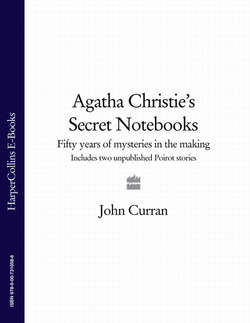Читать книгу Agatha Christie’s Secret Notebooks: Fifty Years of Mysteries in the Making - Includes Two Unpublished Poirot Stories - John Curran - Страница 43
‘How Does Your Garden Grow?’ August 1935
ОглавлениеA plea for help to Poirot is too late to save Amelia Barrowby, but he is determined to get to the truth.
Mary, Mary, quite contrary How does your garden grow? With silver bells and cockle-shells And pretty maids all in a row.
This short nursery rhyme features no less than five times throughout the Notebooks, even though its words gave the title of just one short story, ‘How Does Your Garden Grow?’. But it seems to have made an impression on Christie’s mind as she often referred to it in the course of plotting other titles. And there are similarities between this short story and a novel she planned but never wrote. The story was first published in the UK in The Strand, having appeared some months earlier in Ladies’ Home Journal in the USA. This story’s connection to the nursery rhyme is stronger than ‘Sing a Song of Sixpence’ or ‘Four and Twenty Blackbirds’, as it includes the shells, the garden and the killer’s name. Mary Delafontaine poisons her aunt and hides the shells of the fatal oysters among the other cockle shells used as decoration in her garden. She tries, unsuccessfully, to incriminate the foreign companion:
The old lady—the foreign girl—Mary—the ‘weak’ husband
The final plot is encapsulated in Notebook 20:
Oyster story—Man dies after dinner—strychnine in oyster—swallowed—shells out in garden or in shell box—food analysed—nothing. Possibly some complication about a cachet he took—or someone gave him—if so, unjustly accused
It is another example of one of Christie’s favourite early plot devices—the summoning of Poirot to the scene of a suspected crime only to discover when he arrives that he is too late. As early as 1923 she first used this idea in The Murder on the Links, and subsequently in ‘The Cornish Mystery’, Dumb Witness and ‘The Incident of the Dog’s Ball’ (see the Appendix). It can be seen why—it has an emotional and a practical impact. The summoner, who has promised to explain the situation in detail, is now unable to do so and Poirot has a moral, as well as a practical, imperative to solve the crime. There is also the plot device of the victim having known ‘too much’, always a good way to start a detective story. In ‘How Does Your Garden Grow?’, the appearance of a Russian character would have been very unusual in detective fiction of the day. In fact, the appearance of any foreigner (including Poirot) is always viewed with suspicion by the inhabitants of small villages throughout the Christie canon. And, of course—as can be seen in Dumb Witness—this allowed Christie to subvert, yet again, the readers’ prejudices.
The eponymous main character, Mary Delafontaine, became a byword in Christie’s shorthand, appearing in abbreviated form in the course of plotting Third Girl and Ordeal by Innocence respectively, even though she was used in the final plot of neither novel:
Mary Del.—Arthur (innocent husband)—Katrina—suspicious, passionate—for money looks after old boy
Olivia (The Mary Delafontaine wife)
The name was also used for one of the victims in The Pale Horse; she is a friend of Mrs Oliver in Chapter 1 and she appears on Father Gorman’s doomed list in the following chapter.
